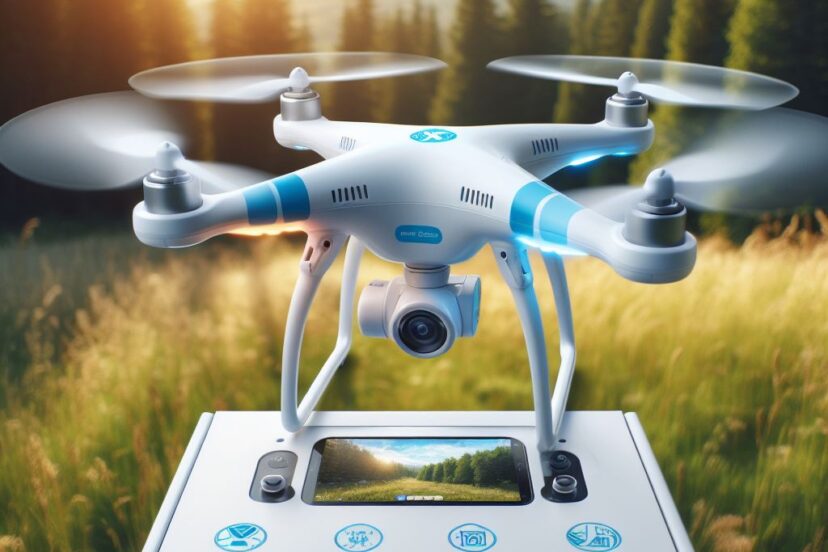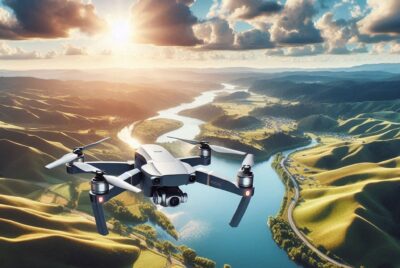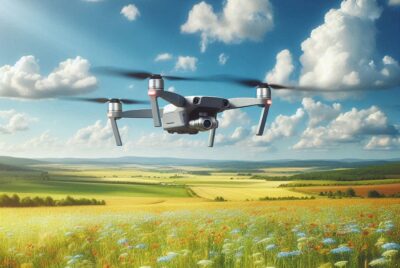Best Drone For Beginners: A Guide to Getting Started
*We may earn a commission for purchases made using our links. Please see our disclosure to learn more.
Best Drone for Beginners: Top Picks for New Pilots
When choosing their first drone, beginners will often look for models that strike an ideal balance between ease of use, reliability, and price. I’ve noticed that most beginner drones come equipped with features such as stability in the air, simplified control schemes, and automated flight modes to ensure a smooth learning curve. Camera quality, too, is a core focus, as budding photographers want to ensure their aerial shots are crisp and clear. From my assessment, a good beginner drone should allow novices to confidently explore drone piloting and photography without overwhelming them with professional-grade complexity or cost.

The market has evolved to accommodate this growing interest in drone photography, especially among novices. Some drones stand out for their user-friendly interfaces, making them suitable for those starting out. Features like automated takeoff, landing, and GPS tracking for easy recovery if the drone goes astray, are invaluable for beginners. Drones designed for novices often include robust safety features, such as obstacle detection, which I find critical for protecting the drone and its surroundings during flight.
Recently, I’ve seen models specifically tailored for beginners come to the fore, promising quality drone experiences without the steep learning curve typically associated with flying drones. Among these, some have gained popularity for their compact size, affordability, and the inclusion of high-quality cameras that rival those found in more advanced models. The balance of user-friendliness and feature-rich performance in these beginner drones ensures that new pilots can enjoy and develop their skills in drone photography and piloting right out of the box.
Choosing Your First Drone

When selecting your first drone, I’ll guide you through essential features and specifications to ensure you make an informed decision. It’s not just about the price; it’s about what fits your needs as a beginner pilot.
Key Features to Consider for the Best Drone for Beginners
The camera quality is crucial if you intend to capture high-quality aerial footage. For example, a drone with a 4K camera can provide stunning video clarity. Flight time and battery life are also key; as a beginner, look for drones that offer a decent balance, with flight times typically ranging from 15 to 30 minutes.
Consider the range, which is how far the drone can fly from your controller. For non-commercial use, something around 4 km is usually more than adequate. Lastly, ease of use is vital—drones that allow for control via a smartphone app can be particularly user-friendly.
Understanding Drone Specifications
| Flight Time | Range | Camera Quality | Control Options |
| 15-30 minutes | Up to 4 km | 4K | Smartphone app integration |
When digging into specifications, I focus on the numbers that will impact my experience. The battery life determines how long I can pilot the drone on a single charge. A longer battery life means more flying time and less frequent charges.
Check if the drone supports GPS or GLONASS for better stability and tracking. The video transmission system affects the quality and distance at which I can view the camera feed on my smartphone or remote. If I want extra features like obstacle avoidance or automatic return to home, I ensure these are included in the drone’s specifications.
Top Drone Reviews for the Best Drone for Beginners

I’ve analyzed the market and consumer feedback to help you choose a beginner drone that suits your needs. Here are the options broken down by model and brand, emphasizing ease of use, reliability, and value.
DJI Drone Models
DJI Mini 3 Pro: The DJI Mini 3 Pro stands out with its powerful camera specifications, including a 1/1.3-inch sensor and an f/1.7 aperture, enabling high-quality imagery. It’s an excellent choice for beginners looking to get a pro-level experience.
DJI Mini 2 SE: Meanwhile, the DJI Mini 2 SE is an affordable option without sacrificing much performance, and was praised for being a low-cost yet high-value drone starting at $339.
DJI Mini 4 Pro: Notably, the DJI Mini 4 Pro is an incremental upgrade from the Mini 3 Pro, maintaining favorable features like the camera and sensor setup, but with further improvements to cater to new pilots.
Ryze Tello and Alternatives
Ryze Tello: The Ryze Tello is often recommended for absolute beginners, thanks to its user-friendly interface and sturdy design – great for learning the ropes without a steep investment.
Potensic Drone Options
Potensic Atom SE: The Potensic Atom SE Drone shines as the best value pick for those on a budget. It’s touted for being well-tested, reliable, and worth the investment for new drone enthusiasts.
Potensic A20: For those looking for an even more accessible entry-level drone, the Potensic A20 is a simple, user-friendly drone perfect for first-time flyers and children.
Crucially, I focused on drones that combine ease of use, reliability, and good investment value. Each of these models presents a worthy option for newcomers to the drone flying community, offering a balance between performance features and beginner-friendly controls.
Best Drone for Beginners: Flight Training

To become a proficient drone pilot, I focus on mastering flight through simulators and practical experience. These tools help me understand the nuances of drone flight controls, including safe execution of automatic takeoffs and landings.
Simulators and Apps
I use simulators and apps to familiarize myself with drone flight controls before real-world flying. Apps like the Tello app provide a user-friendly interface with virtual practice sessions that mimic the drone’s behavior in flight. I find that simulators are particularly beneficial for learning the fundamentals of drone operations in a risk-free environment. They offer an easy-to-fly experience which is perfect for beginners. I ensure to cover these essential features during my simulator training:
- Flight Controls: Learning the response and sensitivity of the joystick controls.
- Automatic Takeoffs and Landings: Practicing these operations to understand their workings.
- Flight Safety: Integrating the knowledge from the Recreational UAS Safety Test (TRUST) into simulated flight scenarios.
Practical Flying Tips
When it comes to practical flying, I start with easy-to-fly drones to build my confidence. I use these practical tips to develop my flying skills:
- Pre-Flight Checklist:
- Battery charged and properly installed.
- Propellers inspected and secure.
- Firmware and software updates checked.
- Start with the Basics:
- Perform automatic takeoffs and landings.
- Practice hovering and gentle maneuvers.
- Safety First:
- Always conduct a visual line-of-sight with my drone.
- Avoid flying in restricted areas and respect privacy laws.
- Take the Recreational UAS Safety Test and adhere to its guidelines.
By following these structured approaches to training, I progress from simulators to actual flying with a clear understanding of flight controls and safety considerations.
Best Drone for Beginners: Safety and Regulations

As a beginner drone operator, I understand that ensuring safety while operating drones and adhering to regulations are crucial aspects of the drone-flying experience. We’ll look at the rules that govern drone flight and how to prevent accidents using drone safety features.
Understanding the Rules
When I fly my drone, I make it a priority to stay updated with the Federal Aviation Administration (FAA) regulations. Specifically, I must register my drone if it weighs over 0.55 lbs (250g) and display the registration number on the aircraft. I’m aware that flying in restricted airspace without permission is prohibited and that flying near other aircraft or over groups of people is not allowed. It’s vital for beginners to familiarize themselves with these rules to avoid legal trouble and to fly responsibly.
- Registration Requirement: Drones over 0.55 lbs must be registered.
- Airspace Restrictions: No flying in restricted zones without clearance.
- Proximity Limitations: Avoid flying over crowds or near other aircraft.
Preventing Drone Accidents
Safety features like obstacle avoidance and collision sensors are particularly important for me as a beginner. These systems help me to navigate around potential hazards and reduce the risk of accidental crashes. For additional safety, drones like the DJI models often come equipped with propeller guards, which I find invaluable in protecting both the drone and any bystanders in case of minor collisions.
- Obstacle Avoidance: Utilizes sensors to navigate around hazards.
- Collision Sensors: Detect potential obstacles to prevent impacts.
- Propeller Guards: Provide physical barriers to guard against contact.
By understanding and utilizing these built-in safety features, I’m able to learn and enjoy drone flying while minimizing risks.
Best Drone for Beginners: Enhancing Your Drone Experience

When I transitioned from a beginner to an enthusiastic drone user, I realized that the true potential of drones extends far beyond basic flying. As I deepened my skills, capturing professional-level content and maintaining my gear, including timely upgrades, played a pivotal role in enriching my drone experience.
Capturing Professional-Level Content
My journey in capturing high-quality aerial photos and videos began with understanding camera resolutions. I found that drones with 4K video recording capabilities provided a striking balance of clarity and detail – essential for professional-looking content. With a 4K-capable drone, each frame contains approximately 8 million pixels, offering me an expansive canvas to play with during post-production.
For aerial video, sharpness and stability are key, so I opt for drones that promise steady footage even in unforgiving conditions. If 4K filming isn’t available or necessary, I ensure at least 1080p video quality to maintain a high standard for my content. On a side note, even though 720p video is available on many beginner drones, I consider it a starting point before swiftly moving to higher resolutions.
When it comes to aerial photography, the larger the camera sensor and the higher the resolution, the better the image quality. A sizeable sensor such as a 1/1.3-inch paired with a good aperture, like f/1.7, provides images with rich details and a decent dynamic range – even in low-light conditions.
- Pro Tip:
- Use 4K video for brilliant details
- Employ 1080p as a solid standard for videos
- Start from 720p but aim higher
- Pursue drones with large sensors for quality aerial photos
Maintenance and Upgrades
Owning a drone is not just about flying it; it’s also about taking care of it. Regular maintenance ensures that my drone remains in top condition. I perform pre and post-flight checks, looking for any damage to the body or the propellers that might compromise the drone’s performance or safety. I also make sure to keep the firmware updated, as manufacturers often release updates that improve functionality and address bugs.
Investing in upgrades can significantly enhance the experience. I often consider additional batteries for extended flight sessions, propeller guards for added safety, and carrying cases for better portability. Upgrading the camera or attaching filters can also result in noteworthy improvements to image and video quality, especially when dealing with challenging lighting.
- Maintenance Checklist:
- Pre and post-flight inspection
- Regular firmware updates
- Battery health checks
- Considered Upgrades:
- Extra batteries
- Propeller guards
- Carrying cases
- Camera resolution boosters
- Lighting filters
By paying attention to these aspects, I have dramatically improved the quality of my drone piloting and the content I produce.
FAQs About the Best Drone for Beginners
In this section, I’ll address some common inquiries that beginners often have when venturing into the world of drones, especially focusing on features, pricing, criteria for selection, GPS capabilities, and suitable options for adults and children.
1. What features should a beginner look for in a drone with a camera?
When selecting a beginner’s drone with a camera, I recommend looking for drones with stable hovering, simple controls, and durable design. A camera with decent resolution, such as 4K, is a bonus for capturing clear images and videos.
2. How much is typically spent on a beginner’s drone?
The cost of a beginner’s drone can vary widely, but typically it ranges from under $100 to around $500. I suggest starting with a budget-friendly option with the necessary features for learning to pilot.
3. What criteria are important when selecting your first drone?
When I selected my first drone, I prioritized ease of use, stability, and a reliable customer service for support. Generally, it’s smart to consider flight time, battery life, and the availability of replacement parts.
4. Which drone is recommended for beginners who want to include GPS capabilities?
For beginners interested in GPS features, I recommend drones like the DJI Mini 2. It offers GPS as well as good flight time, making it a great choice for newcomers seeking better control and tracking.
5. What is considered the best entry-level drone for adult rookies?
In my opinion, the DJI Mini 2 stands out as the best entry-level drone for adult beginners. It balances ease of use, cost, and performance, making it a highly recommended drone for first-time flyers.
6. What are the recommended drones for children just starting out?
For children just starting out, drones such as the Potensic A20 are ideal due to their user-friendly controls and robust design. They offer a safe and enjoyable introduction to flying drones.




